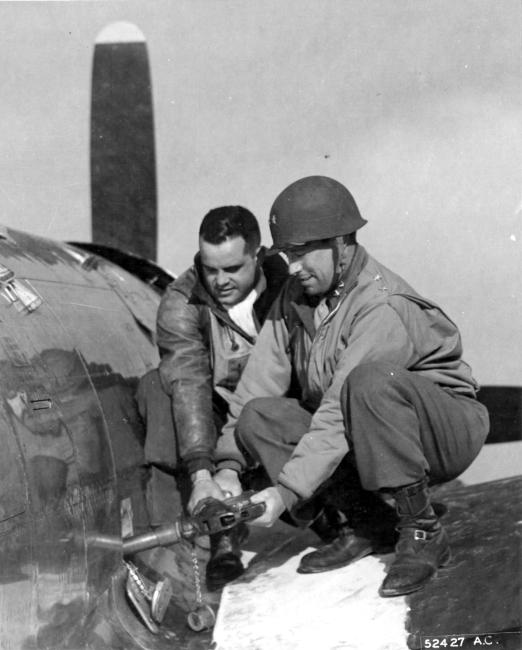Elwood Richard Quesada
Military
- Maj Gen Elwood Richard "Pete" Quesada .
Object Number - UPL 32063 - "Major General Elwood R Quesada seated in the cockpit of a Lockheed P-38 at an air base somewhere in England. 27-May-44." - Maj Gen Elwood...
Obituary reads:
Lt Gen [retd] Elwood Richard Quesada, a WW II fighter pilot who became the first head of the Federal Aviation Administration, died yesterday at Jupiter Hospital in Jupiter, Fla. He was 88 and lived in Hobe Sound, Fla. His family said he died of heart failure.
General Quesada spent most of his professional life in aviation or related industry. He enlisted as a private in the Regular Army in 1924, but soon became a flying cadet and a commissioned officer. By the time he left military service as a three-star general in 1951, at the age of 47, he had spent 25 years in the Air Force and its predecessor branches, the Army Air Corps and the Army Air Forces.
He turned to private business in electronics and aircraft until 1957, when President Dwight D. Eisenhower asked him to serve as a special assistant in aviation. In 1958 Congress established the F.A.A. to regulate air commerce and flight operations and to set standards for aircraft safety.
The stipulation was that the administrator of the agency had to be a civilian, so General Quesada formally resigned his commission. Congress passed a special bill enabling him to reclaim his military status and collect retirement pay after his stint at the aviation agency ended in 1961.
General Quesada's overriding concern for safety prompted him to come down hard on those suspected of negligence. He cited statistics showing that accidents often were a result of inexcusable human error.
"If I accomplish nothing else," he once said, "I hope to make the entire F.A.A. staff conscious of our primary obligation to serve the public interest."
He noticed that pilots and co-pilots sometimes strolled through the passenger cabin when they were supposed to be at the controls. "This practice must cease forthwith," he ordered.
Elwood Richard Quesada was born on April 13, 1904, in Washington to Lope Lopez Quesada and the former Helen A. McNamara. He attended Washington public schools and studied at the Wyoming Seminary in Pennsylvania, the University of Maryland and Georgetown University before joining the Army.
He was commissioned as a second lieutenant in the Army Air Corps in 1927, and got his first taste of fame the next year while on duty at Bolling Field in Washington. Lieutenant Quesada was one of the pilots sent to rescue the crew of the German aircraft Bremen, which crashed in Labrador after making the first east-to-west trans-Atlantic flight.
In 1929 he was a member of a team aboard Question Mark, a tri-motor Fokker that stayed aloft for days to demonstrate that midair refueling could work. The team used a garden hose trailing from another plane.
Also on the team was Carl Spaatz, the first man to command the Air Force when it became independent of the Army in 1947.
After some diplomatic and desk assignments, General Quesada was given his first operational command at Mitchell Field, L.I. He was promoted to brigadier general in 1942, the year after the United States entered World War II, and was placed in command of an air wing that first saw combat in North Africa. Action at Normandy
He flew many missions, and his pilots called him "Pete" and "the pilots' general." He was sent to England to lead the Ninth Fighter Command, consisting of P-38's, P-47's and P-51 Mustangs, and took part in planning the invasion of Normandy.
He moved his command to Omaha Beach on June 7, 1944, the day after D-Day, to direct fighter sorties in support of the advancing tanks and infantry. Eisenhower, then a four-star general who led the invasion, chose General Quesada to fly him over the battlefield on observation missions.
After the war, General Quesada joined the Lockheed Aircraft Corporation, but quit over a policy dispute in 1955. When Eisenhower recalled him to Washington he helped draft the legislation that established the F.A.A. and led the agency until the President's second term ended in 1961.
After leaving the aviation agency, General Quesada was president of L'Enfant Properties, which developed L'Enfant Plaza off Independence Avenue in Washington, from 1963 to 1977.
From 1973 until his retirement in 1978 he also was the first chairman of the Pennsylvania Avenue Development Corporation, a Government-chartered body charged with encouraging the improvement of the thoroughfare between the White House and Capitol Hill.
In addition, he sat on corporate boards and, until recently, attended annual "elder statesmen" meetings at the Pentagon with the Air Force Chief of Staff.
Awards: Distinguished Service Medal with oak leaf cluster; Distinguished Flying Cross; Purple Heart; Air Medal with two silver stars; American Defense Service Medal; European-African-Middle Eastern Campaign Medal and seven bronze battle stars; World War II Victory Medal; British order of Bath (Degree of Companion); Commander of British Empire; French Legion of Honor; French Croix de Guerre with Palm; Luxembourg Croix de Guerre; Order of Adolphe of Nassau; Polish Pilot Badge; Conmandeur de l'Ordre de la Couronne with Palm; Croix d'Officier de l'Order de la Couronne with Palm.
Connections
See how this entry relates to other items in the archive by exploring the connections below.
Aircraft

- Aircraft Type: P-51 Mustang
- Nicknames: Short-Snorter - The Stars Look Down
- Unit: 354th Fighter Group 355th Fighter Squadron
Missions
- Date: 6 June 1944
- Official Description:
Events
| Event | Location | Date | Description |
|---|---|---|---|
|
Born |
Washington, DC, USA | 13 April 1904 | |
|
Died |
Jupiter, FL, USA | 9 February 1993 | |
|
Buried |
Arlington National Cemetery Arlington, Arlington County, VA |
Revisions
https://www.fold3.com/image/312406338?terms=Elwood%20R%20Quesada
http://www.af.mil/About-Us/Biographies/Display/Article/106101/lieutenan…
http://www.arlingtoncemetery.net/erquesada.htm
https://www.faa.gov/about/history/people/media/Elwood_Quesada.pdf
https://www.findagrave.com/memorial/18233/elwood-richard-quesada
https://www.fold3.com/image/312406338?terms=Elwood%20R%20Quesada
http://www.af.mil/About-Us/Biographies/Display/Article/106101/lieutenan…
http://www.arlingtoncemetery.net/erquesada.htm
https://www.faa.gov/about/history/people/media/Elwood_Quesada.pdf
https://www.findagrave.com/memorial/18233/elwood-richard-quesada









